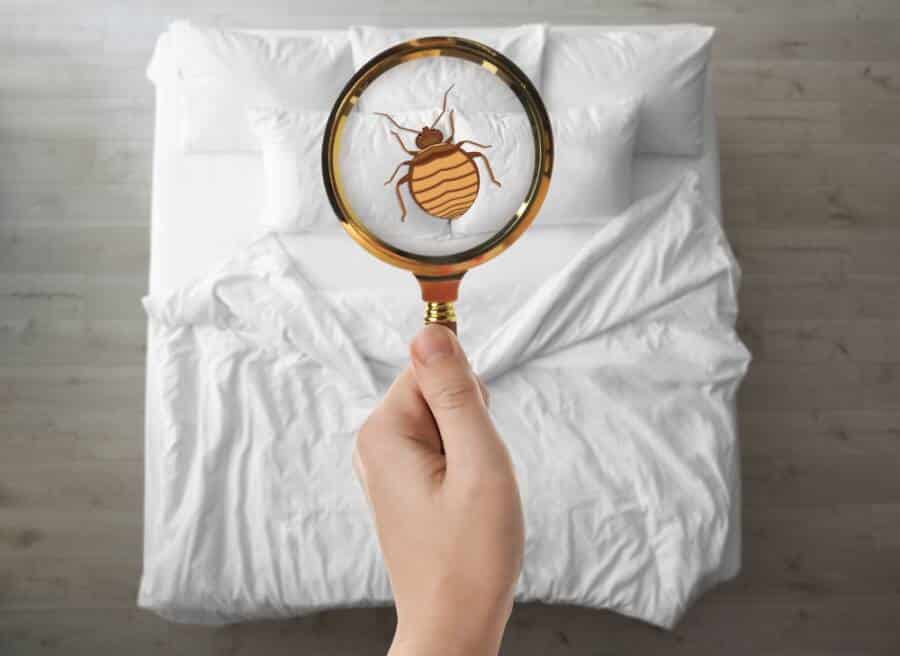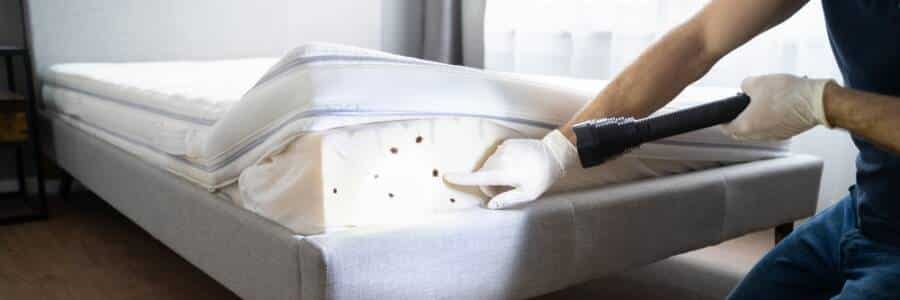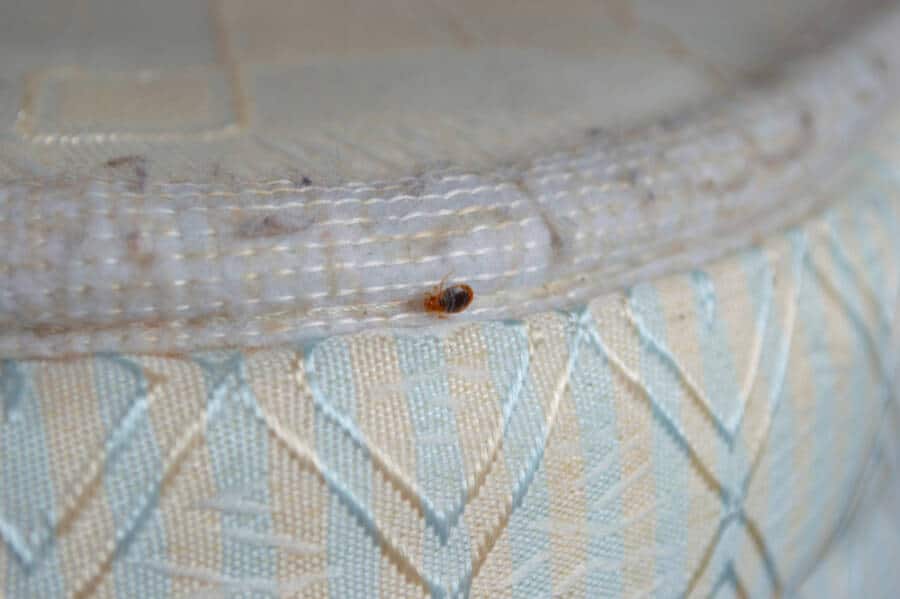Let’s talk about bed bug infestations!
If you’ve ever had a bed bug infestation, you surely know how hard it is to deal with them. And you’ve probably wondered what caused those parasitic insects to come into your home in the first place.
Tiny and elusive, these creatures feed on the blood of humans and animals. The worst part? They’re resilient and can easily adapt to different environments—hotels, homes, and anywhere people sleep.
Here’s the thing: having a bed bug infestation doesn’t mean your home isn’t clean. These parasites are expert hitchhikers, often transported in used furniture, clothing, and luggage, without you even knowing.
While they’re usually attracted to their hosts (aka you), there are a few reasons why certain people or homes are more likely to be targets. Today’s article is all about bed bug infestations: what they are, how to know if you have unwanted guests, and why they’re drawn to you like moths to a flame. Intrigued? Disgusted? Either way, keep reading.

What are bed bugs?
These annoying parasites are tiny, oval-shaped insects, about the size of an apple seed. They’re nocturnal pests, have flat brown bodies, and swell and turn a reddish color after feeding. Even though they can’t fly, they’re speedy and can quickly move over ceilings, walls, and floors.
One of the worst parts? Females can effortlessly lay hundreds of eggs, each around the size of a speck of dust, throughout their lifetime. Small bedbugs, also known as nymphs, shed their skins roughly five times before reaching maturity, and they need a “delicious” meal before each shedding.
While these parasites don’t transmit diseases, their bites can lead to allergic symptoms, skin rashes, anxiety, insomnia, and stress. Since they’re weird to be active at nighttime, they will hide in bed frames, mattress seams, and headboards during the day, making them very difficult to spot.
Do you have a bed bug infestation?
One of the most effective ways to prevent a bedbug infestation from turning into a major disaster is to identify it as soon as possible—and I can teach you how.
The first thing you should pay attention to is the appearance of itchy, small, red bites on your skin. These are usually clustered together and might appear in a line. Even though the bugs won’t make an appearance during the day, they will leave behind signs of their presence.
Look for brown or black spots on your bedding—those are their droppings. You might also notice a musty, sweet odor coming from your furniture.
But that’s not all. The third sign that something’s not right is the presence of their exoskeletons. Remember when we discussed that nymphs shed around five times as they grow? Well, those clear or yellowish shells will be left behind as a “thank you note” for welcoming them.
If you see any of these signs, you’d better pick up the phone and call a professional pest control service ASAP! Taking care of the issue in its early stages is one of the best ways to handle the problem and prevent it from escalating.
What causes bed bug infestations?
1. Buying used furniture
While used furniture is a fabulous way to add some unique decor pieces, repurpose old items, save some money, and be more environmentally friendly, it also comes with the risk of bringing bed bugs into your home.
I don’t suggest you stop buying used furniture altogether, because it can look marvelous, but rather, carefully inspect it before bringing it into the house. It can save you lots of trouble shortly!

2. Traveling
Traveling is among the most exciting and enriching activities you can take part in, but it also comes with the risk of tiny pests hitching a ride and finding a new home in your luggage. These insects have the time of their lives in carpets, mattresses, and even in the folds of your clothes.
And here’s the thing: these parasites don’t only thrive in dorm rooms or cruise ships. They also love staying in hostels, hotels, people’s homes, and even public transportation. Bed bugs can even hide in loose wallpaper, cracks, and crevices.
Remember to always inspect your belongings before you pack your bags. Look for nymphs, eggs, exoskeletons, or droppings. Other than that, carefully inspect hotel rooms for any signs of unwanted guests and make sure you keep your luggage away from the bed and off the floor.
For an extra preventive measure, launder and heat-treat the clothes and luggage you had with you on vacation. Keep in mind that the carbon dioxide you exhale and your body heat make you a desirable guest to these pests, so always take precautions.
3. Buying used and infested items
Another way to end up with a bed bug infestation is by purchasing infested items. Since these pests are pros at hiding, they can sneak into all kinds of things—electronics, linens, luggage, and clothing included.
Just like with the used furniture pieces we discussed earlier, buying secondhand items—or even borrowing from friends or family who unknowingly have an infestation—is a surefire way to invite some unwanted guests into your home.
If you’re buying used things, make sure to thoroughly inspect them before paying. Once home, launder and heat-treat them before use to stay on the safe side.

4. People coming over
This might not sound pleasant, but it’s true: if guests come over and they have a bed bug infestation at home, they might bring some extra visitors without even realizing it. This can also happen if they’ve recently stayed in hotels or other infested accommodations and then come directly to your place.
If their clothes or belongings carry these tiny and annoying pests, bed bugs can transfer to your space in no time. To stay safe, inspect the bedding and the room your visitors stayed in. Launder all bedding in hot water and dry on high heat to clean everything properly—and avoid getting stuck with some very unwanted guests.
5. Sharing living or public spaces
Bed bug infestations aren’t limited to hotels or residential homes. Believe it or not, they’re pretty common in apartment buildings, where they can easily travel from one apartment to another.
Bed bugs can hitch a ride between apartments in multi-unit buildings through shared walls, plumbing, and electrical systems. If your neighbors have an infestation and don’t act quickly, you could soon be dealing with them too.
These pests aren’t picky can can thrive in a plethora of spaces. A single bed bug can spread across your entire home, sneaking in on your clothes without you even noticing.
To avoid an infestation, stay alert wherever you go, and protect your home from these sneaky invaders! Prevention is better than treatment!
Takeaway
A bed bug infestation is one of the worst things you could deal with, so always stay cautious. Inspect all the used items you plan on bringing into your home, and make sure to book a hotel room that’s safe from pests. Avoid sharing items with friends and family, and always be on the lookout for signs of unwanted guests.
If you find yourself dealing with an infestation, don’t wait—call a professional exterminator to tackle the issue as quickly as possible. The sooner you act, the less damage these pests can cause.
In the meantime, keep your home and loved ones safe by cleaning your space with this effective anti-bed bug solution. Have you ever had to deal with a bed bug infestation? What steps did you take? Let me know in the comments below!
And before you go, check out another helpful post from The Home Team right here: 11 Reasons Your Indoor Air Quality Isn’t as Pure as You Think









